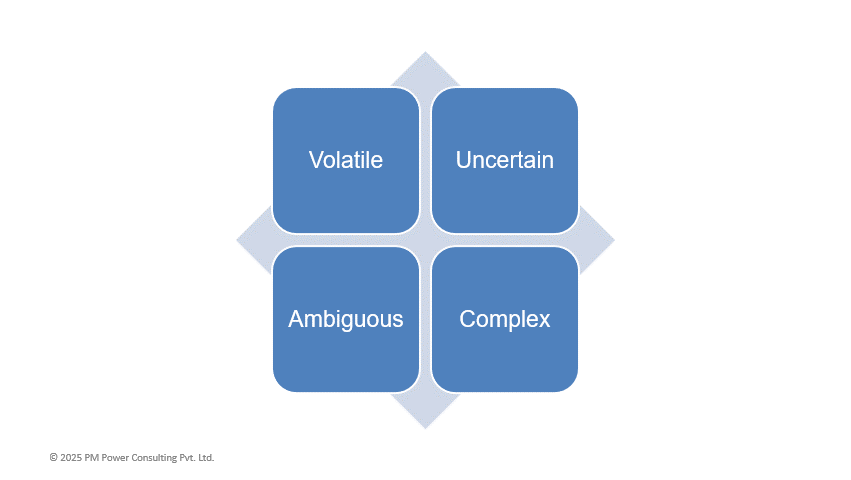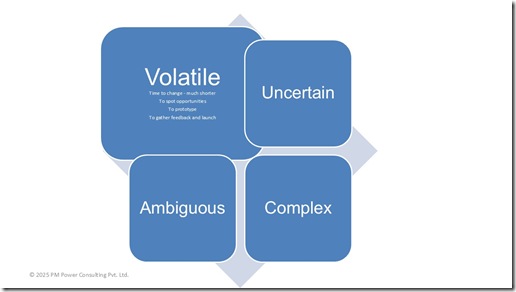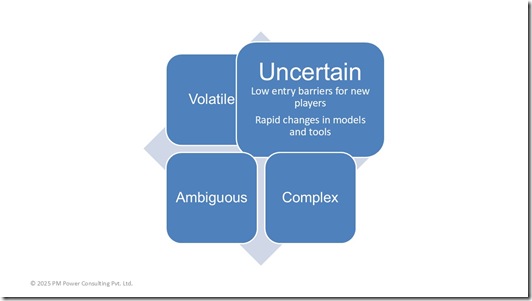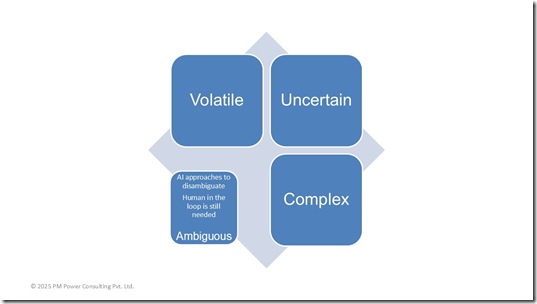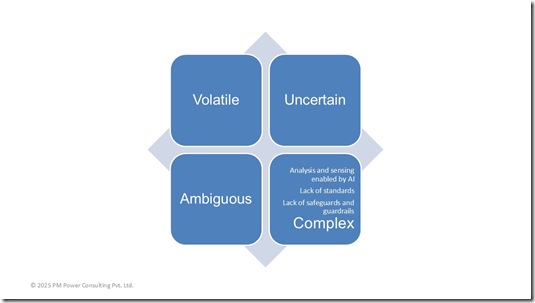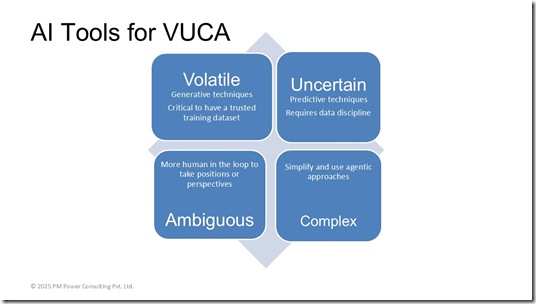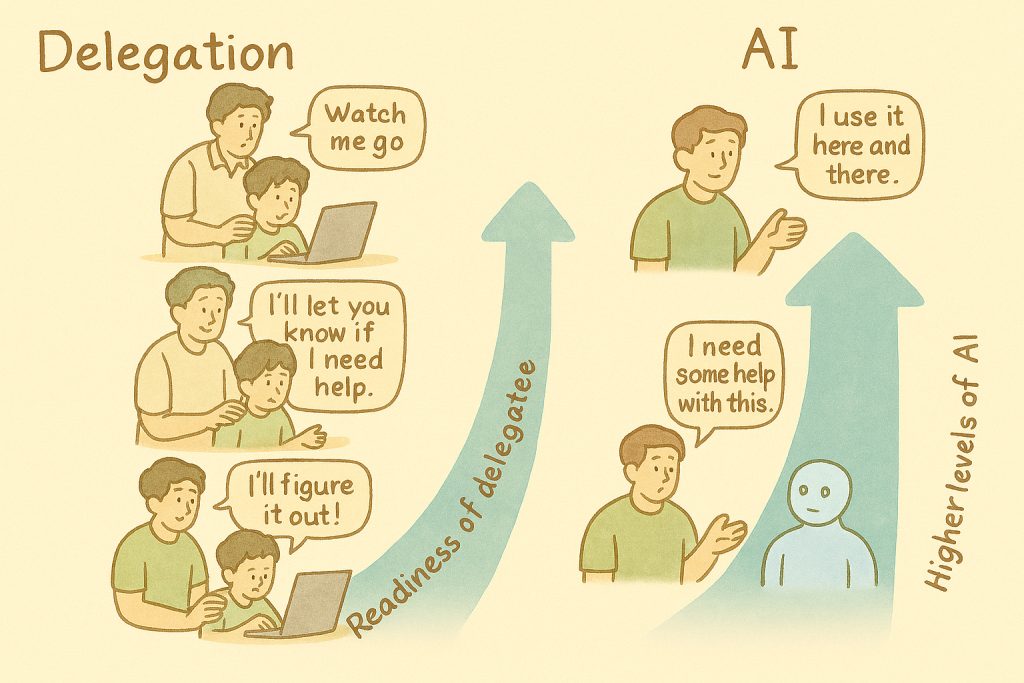Ever since the US Army introduced the term VUCA, it has been adopted and interpreted to derive meaning in areas of business strategy and leadership too.
The general idea behind this model – or the later BANI [Brittle, Anxious, Non-linear and Incomprehensible] model, the common aspects were related to ambiguity, uncertainty and disruption.
The development and adoption of AI approaches and AI based tools has grown significantly in the last couple of years.
In this context, when one throws in AI in the mix, it makes for interesting implications.
My view is that AI needs to be considered as an aid for humans to excel.
Autonomous actions [driving, warehouse management etc] are maturing in limited contexts, with some human oversight to ensure that the guardrails are respected.
The exuberance around all things AI is expected to add more spice to the VUCA cauldron.
When viewing the world through a VUCA lens, one would find that the cognitive load needed to make sense of everything happening around is very high.
Let us look at how AI approaches and applications might influence the four dimensions of VUCA.
Ai approaches – particularly the GenAI based applications, including code generation have enabled significant reduction in time to market for PoCs and early betas.
For standalone or point utilities, these tools have also shifted the power equation from IT teams to end users.
The ability to dish up a quick prototype or a simple working application – sometimes full websites with interactivity – means that one can spot opportunities much faster and validate assumptions, reducing time to launch.
Since these technologies and tools are available to all, barriers to entry are also lower for a new entrant.
The total effect of all this is to increase the volatility in the ecosystem.
The lower entry barriers for new players would imply that for the users, there would be more choices.
On the one hand, this might sound good, but on the other, the increased activity also results in increased and rapid obsolescence.
One common frustration for application developers based on foundational models is that by the time they have a version 1, the model has changed!
The number of such models are also increasing with many players publishing their models as open source.
The uncertainty also influences organizations to think less long term strategy that is deterministic to shorter timeframe goals that get refined long the way.
Most non-trivial solutions these days leverage the ecosystem [think of Google Maps or payment gateways and settlement systems] and so any changes in any of the portions of the environment will have a big impact on interaoperability.
This also adds complexity to systems being backward compatible, at least for a few generations.
So, we can confidently say that AI has the potential to increase the uncertainty in the business environment.
Ambiguity can result from multiple factors – from incomplete information, use of specific language constructs or visual indicators that could be interpret in multiple ways.
AI models draw their inferences from the data that they are trained on. When using foundational models, one cannot be sure if the data used to train the model is relevant to the current context of exploration.
This could result in generic results that would make sense linguistically, but not useful in the context of the conversation.
The power of AI to analyze large amounts of data, make predictions or projections as well as the ability to ingest information from multiple sources to provide a combined view and perspective is very useful to disambiguate.
One needs to be careful and specific to provide the context along with constraints as part of a prompt, to derive meaningful and relevant results.
While such tools could give us summaries and analysis, one should make sure that the larger context is not lost.
That would require a human in the loop to generate perspectives relevant to the context.
So, it is reasonable to infer that AI approaches will help in reducing ambiguity.
For aspects that are generally considered complex, the first step is to explore if it could be simplified.
Some of the disambiguation exercises could provide clues to simplify or reduce the complexity.
But, these would have to be based on the collective wisdom of the experts.
Unfortunately, we do not have proper rules, guidelines or safeguards to have confidence that the training data used by a model has not been poisoned.
For many organizations, it may be very expensive in terms of cost and time, to train an in-house model for use in such situations.
Since there are many moving parts [read subsystems or components], including the choice of solutions from multiple providers, it is unlikely that AI would have a significant impact on the complexity.
We could then infer that AI approaches alone would have minimal impact on complexity.
Knowing that he aspects of VUCA would need different approaches to be considered, we can pick the appropriate tools to manage these dimensions.
To manage volatility and be more responsive and Agile, generative techniques could help in the time to completion of many cognitive activities.
As mentioned earlier, the need for having a trained context [or trained model] to be relevant for the task at hand would require careful thought and planning.
This is also likely to be time consuming, to capture data – though unstructured – and build a reliable data set.
To manage uncertainty, use of prediction models may be considered.
For these models to work effectively, the quality and quantity of data – typically historical – are very important.
Adopting a data driven culture with a discipline to manage by data will be very useful in the long run.
To reduce ambiguity, strategic positions or decisions would need to be taken by the leadership roles.
While AI addresses mostly the ‘head’ based activities, to include the contributions of the ‘heart’ and ‘gut’, it requires people with experience or instinctive insights.
To summarize, stay cognizant of the evolution of AI approaches, experiment with relevant approaches and appropriate tools, and, enjoy the party!
p.s.
you may want to also read a sister blog post on picking the right horses for the courses.


